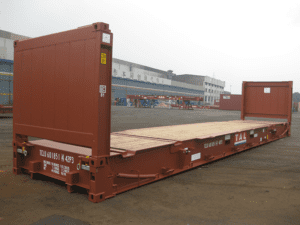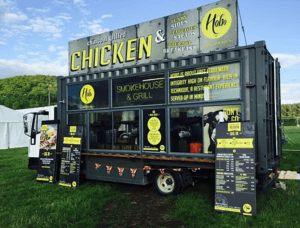Introduction
Shipping containers have become a versatile solution for various needs, from storage and transportation to creating functional spaces. With the array of container sizes and types available, it can be overwhelming to select the perfect fit for your project. That’s why we’ve created this comprehensive guide to help you navigate the world of containers and make the best decision for your needs. At K3 Containers and Transport, we pride ourselves on providing top-of-the-line used containers and reliable delivery services to suit every requirement.
1. Understanding Container Sizes and Terminology
Before diving into the selection process, it’s essential to familiarize yourself with standard container sizes, specialized types, and common terminology. This knowledge will help you make informed decisions and communicate effectively with container providers.
A) Standard container sizes and their dimensions
Standard containers are widely used for storage, transportation, and conversion projects. These containers are available in various sizes, including:
- 10-foot containers, which measure 10′ L x 8′ W x 8.5′ H, are ideal for small storage needs, limited spaces, or compact conversion projects. They’re often used for temporary site offices, garden sheds, or small workshops.
- 20-foot containers, measuring 20′ L x 8′ W x 8.5′ H, are versatile and commonly used for storage, shipping, and various conversion projects. Their popularity is due to their manageable size, ease of transportation, and adaptability for purposes such as pop-up shops, cafes, or art studios.
- 40-foot containers, with dimensions of 40′ L x 8′ W x 8.5′ H, are suitable for larger storage or shipping needs, as well as spacious conversions such as offices, workshops, or homes. Their size makes them popular for commercial and industrial applications, as well as for creating multi-room living spaces.
- 45-foot containers, measuring 45′ L x 8′ W x 9.5′ H, are perfect for oversized cargo or creating even larger functional spaces through conversion. Their extra length and height provide additional storage and living area, making them ideal for larger projects or luxury container homes.
B) Specialized container types and their uses
In addition to standard containers, there are specialized container types designed for specific purposes:
- High cube containers are taller than standard containers, typically offering an additional foot in height (9.5 feet). This extra space allows for increased storage capacity or higher ceilings in container conversions, making them popular for commercial, retail, or residential projects.
- Open-top containers are designed without a fixed roof, making them ideal for loading oversized items or cargo that must be accessed from the top. They are often used for transporting large machinery, vehicles, or materials that exceed the height of standard containers.
- Flat rack containers have collapsible walls and are suitable for transporting heavy or wide loads that cannot fit within enclosed containers. These containers are commonly used for shipping construction equipment, boats, or other bulky items.
C) Terminology
When discussing container sizes and shipping capacities, there are some common terms you should be familiar with:
- TEU (Twenty-Foot Equivalent Unit) is a standard measure used to express the capacity of container ships and terminals. It is based on the size of a 20-foot container and helps compare the volume of different container sizes.
- FEU (Forty-Foot Equivalent Unit) is a measure twice the size of a TEU, representing a 40-foot container. This term allows for easier comparison between container capacities when dealing with larger containers.
2. Factors to Consider When Choosing a Container Size:
Selecting the right container size involves various factors, such as its purpose, destination site, load capacity, budget, and environmental considerations. Carefully considering these factors will help you make the best decision for your specific needs.
A) Purpose of the container:
The intended use of the container plays a significant role in determining the appropriate size. Here are some common purposes and their corresponding considerations:
- Storage: Assess the volume of items you need to store, keeping in mind any potential future storage needs. Opt for a container size that can accommodate your belongings comfortably and efficiently.
- Shipping: When shipping cargo, take into account the dimensions, weight, and applicable regulations for your items. Choose a container that safely and securely holds your cargo without exceeding weight limits or violating shipping rules.
- Conversion: For container conversions, such as offices, workshops, or living spaces, plan for the intended use and desired layout. Consider the required space for furnishings, equipment, and other essentials, as well as any building regulations and zoning requirements.
B) Space limitations at the destination site:
Before selecting a container size, evaluate the available space and accessibility at your destination site. Ensure there is adequate room for container placement and delivery, including the necessary clearance for delivery vehicles and equipment. Additionally, verify any local zoning or permit requirements for container installation to avoid complications or fines.
C) Load capacity and weight restrictions:
Review the maximum payload and overall weight capacity of your chosen container to ensure it meets your requirements. Keep in mind that exceeding a container’s weight limit can lead to safety hazards and increased transportation costs. Also, ensure the container meets any transportation or site-specific weight limitations to avoid potential issues.
D) Budget constraints:
While considering the costs of various container sizes and types, factor in both the initial purchase price and any ongoing costs, such as maintenance, transportation, and modifications. Weigh the potential long-term value of investing in a larger or specialized container against your budget constraints to make the most informed decision.
E) Environmental factors and local regulations:
Evaluate the impact of weather, climate, and other environmental conditions on your container selection. Choose a container that can withstand the elements and provide adequate insulation, ventilation, or protection based on your specific needs. Comply with local regulations and guidelines for container use and placement to ensure your project proceeds smoothly.
3. Popular Container Sizes and Their Applications:
Each container size has unique advantages and applications, depending on your project requirements. Here’s a more in-depth look at popular container sizes and their potential uses:
A) 10-Foot Containers:
These compact containers are perfect for small-scale projects or when space is limited. They are often used for temporary site offices, garden sheds, small workshops, or secure storage for residential or commercial purposes. Their manageable size makes them easy to transport and install.
B) 20-Foot Containers:
As one of the most versatile container sizes, 20-foot containers are popular for a wide range of applications. They are an excellent choice for small to medium-sized storage needs, shipping cargo, or conversion projects like pop-up shops, cafes, or art studios. Their adaptability and ease of transportation make them a popular choice across various industries.
C) 40-Foot Containers:
With twice the length of a 20-foot container, 40-foot containers are suitable for larger storage or shipping needs. They are also a popular choice for spacious conversions, such as offices, workshops, or homes. Their size makes them ideal for commercial and industrial applications or for creating multi-room living spaces with ample room for customization.
D) 45-Foot Containers:
These extended containers provide additional length and height, making them perfect for oversized cargo or creating even larger functional spaces through conversion. Their extra storage and living area make them ideal for larger projects, luxury container homes, or accommodating unique cargo requirements.
4. Customizing Containers for Your Needs:
Once you’ve chosen the appropriate container size, you may need to customize it to meet your specific requirements. Customizations can range from simple modifications to extensive conversions, depending on your project’s needs.
A) Modifications and add-ons:
Many container providers, including K3 Containers and Transport, offer a variety of modifications and add-ons to enhance your container’s functionality. Some popular options include:
- Installing doors and windows for improved accessibility and natural light
- Adding insulation, heating, or cooling systems for temperature control
- Incorporating electrical systems for lighting and power outlets
- Installing shelving, partitions, or storage solutions for better organization
B) Container conversions for specific industries or uses:
Containers can be transformed into functional spaces tailored to your industry or intended use. Some examples of container conversions include:
- Offices: Equipped with desks, chairs, and storage solutions, these spaces provide a cost-effective and flexible alternative to traditional office buildings.
- Workshops: Outfitted with workbenches, tools, and equipment storage, containers can be converted into practical workshops for various trades or hobbies.
- Living spaces: With proper insulation, plumbing, and electrical systems, containers can be transformed into comfortable living spaces, such as tiny homes, guest houses, or vacation rentals.
C) Choosing the right container provider:
Selecting the right container provider is crucial for a successful project. K3 Containers and Transport not only offers a range of high-quality used containers but also provides expert guidance and assistance in choosing the ideal container size and customizations for your needs.
5. Ensuring a Smooth Container Delivery Process:
After selecting and customizing your container, it’s essential to ensure a smooth delivery process. Here are some tips to help you prepare:
A) Preparing the site for container delivery:
Before your container arrives, clear the area where it will be placed and ensure there is adequate access for delivery vehicles and equipment. Consider any obstacles, such as trees, power lines, or fences, that might impede the delivery process. Ensure the ground is level and stable to provide a solid foundation for your container.
B) Understanding delivery options and costs:
Discuss delivery options with your container provider to determine the most suitable method for your site and project. Keep in mind that different delivery methods may have varying costs and requirements, so factor these into your overall budget.
C) Communication with the container provider during the process:
Maintain open communication with your container provider throughout the delivery process to ensure timely and accurate delivery. Address any questions or concerns promptly and provide any necessary information or updates to prevent delays or misunderstandings.
Conclusion
Choosing the ideal container size for your needs can be a complex decision, but by considering factors such as the container’s purpose, available space, load capacity, budget, and environmental concerns, you can confidently select the best option for your project. Remember, the team at K3 Containers and Transport is here to provide expert guidance and assistance to help you navigate the world of containers and ensure your project’s success.
Ready to find the perfect container for your needs? Contact K3 Containers and Transport today to explore our inventory of top-quality used containers and discuss your customization options.




